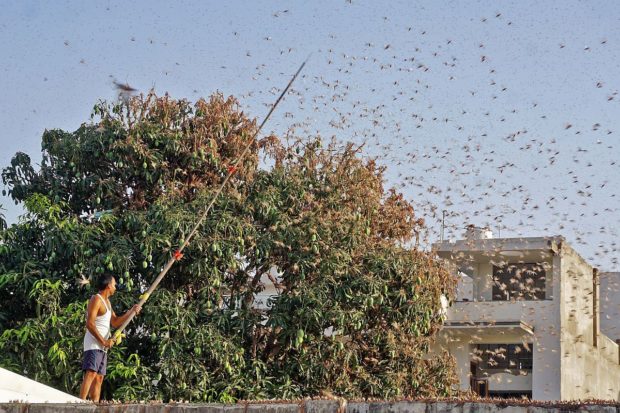Swarms of locusts reach Delhi outskirts; pilots told to stay alert

A resident tries to fend off swarms of locusts from a mango tree. AFP via The Statesman/Asia News Network
NEW DELHI — Swarms of crop-destroying desert locusts have entered the outskirts of Delhi after being spotted in several parts of Haryana’s Gurugram district earlier on Saturday.
Locusts were seen in Rajendra Park of sector 5, Surat Nagar, Dhanwapur, Palam Vihar, Maruti factory in sector 18, Sector 17 DLF phase 1 and many other places in old and new Gurugram.
With thousands of locusts covering the sky in Gurugram, the Haryana government has issued a high alert with officials saying that all necessary measures have been taken, including deploying tractor-mounted spraying facilities, according to news agency PTI.
Delhi Environment Minister Gopal Rai on Saturday called an emergency meeting to discuss the situation. The minister also directed the administration to be alert and asked officials of the Agriculture department to make field visits in areas close to Gurugram.
The development secretary, divisional commissioner, director, Agriculture department, and the district magistrates of South Delhi and West Delhi attended the meeting, as per reports.
Article continues after this advertisement“As per the information we’re getting, the swarms of locusts are headed towards Palwal (in Haryana). But a small portion has entered Jasola and Bhati (at Delhi border). An instruction as been issued to beat dhols and drums. This is a way to ward them off… the government will issue an advisory on this,” Gopal Rai was quoted as saying by NDTV after the meeting.
Article continues after this advertisementFollowing the meeting, the state government issued an advisory on preventive measures to control probable pest attack in the national capital and asked all district magistrates to remain on high alert.
The concerned authorities have been advised to carry out spraying of pesticides and insecticides like Melathion and Chloropyriphos as required during night, with the help of spraying equipment.
The DMs have been advised to guide villagers and residents to distract the locusts by making high-decibel sound through beating of drums, utensils, burning crackers and neem leaves etc.
Further, residents have been asked to keep doors and windows closed as well as cover outdoor plants with plastic sheet.
The advisory also states that the locusts should not be allowed to rest especially during the night as they usually fly in day time and rest during the night.
Meanwhile, in view of locust swarms seen near the airport in areas along Gurugram-Dwarka Expressway, Delhi Air Traffic Control (ATC) on Saturday directed pilots of all airlines to take necessary precautions during landing and take-off of aircraft.
“Pilots of all airlines have been warned about the locust has seen near the airport, we have set up a team to monitor in view of the locust,” a senior ATC official told ANI.
In May, India battled a devastating desert locust outbreak. The crop-destroying swarms first attacked Rajasthan and then spread to Punjab, Gujarat, Maharashtra and Madhya Pradesh.
According to experts, broadly four species of locusts are found in India – desert locust, migratory locust, Bombay locust and tree locust. The desert locust is considered the most destructive.
It multiplies very rapidly and is capable of covering 150 kilometers in a day.